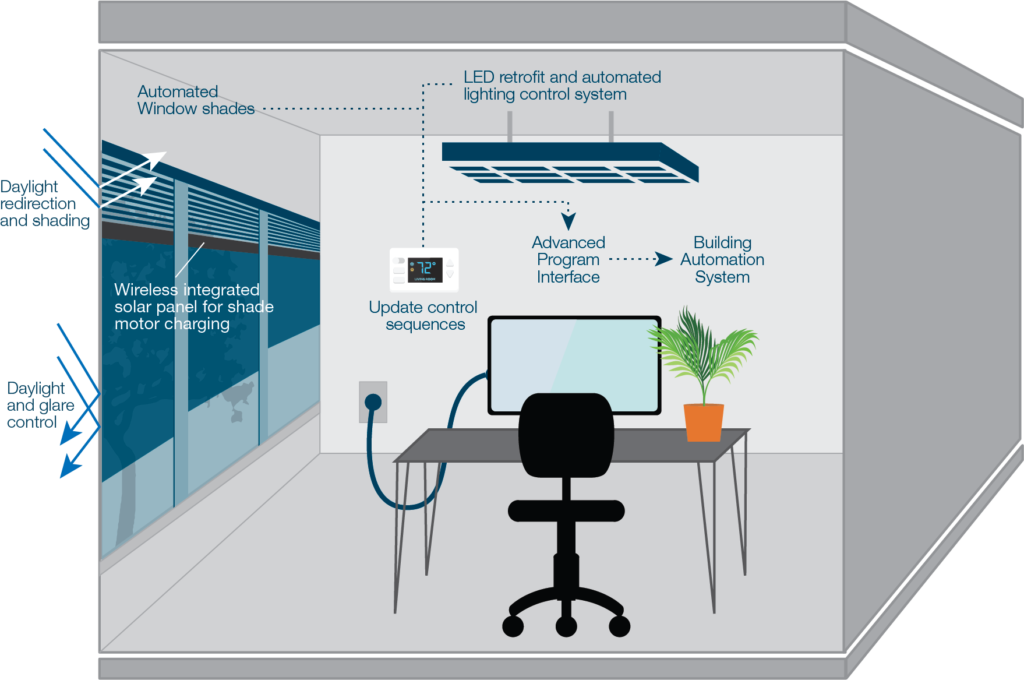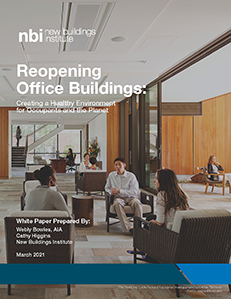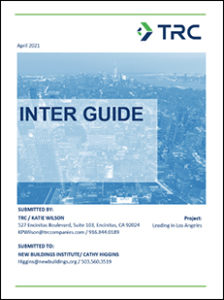New Buildings Institute led a major research project funded by the California Energy Commission in response to the critical need to greatly reduce energy use in California’s existing commercial buildings with cost-effective and scalable solutions. Working with prominent energy efficiency entities TRC Companies (TRC) and Lawrence Berkeley National Lab (LBNL), the project launched in June 2017. The four-year project included lab testing, field demonstrations at two sites, and market connection activities and resources to move an integrated set of emerging commercial retrofit technologies into wider adoption.
Jump to:
Market Resources | Case Studies | Project Results
THE ‘INTER’ SOLUTION
Leading in Los Angeles (LiLA) combines an innovative set of commercial technologies targeted across lighting, shading, and HVAC. These end uses make up the majority of a building’s energy use (70% for a typical office).
The technology package consists of:
- Advanced lighting and wireless controls
- Automated solar-powered window shades
- Light HVAC retro-commissioning to update control sequences
The set of technologies are called the Integrated Technologies for Energy-efficient Retrofits (INTER) solution set and are comprised of shading products from Rollease Acmeda and lighting systems and controls from Enlighted and Daintree. The technologies can be combined and customized to suit a variety of building types and spaces. At two demonstration sites, the packages resulted in significant energy reduction for both lighting and the whole building. In addition to energy savings, the package offers significant occupant comfort and wellbeing benefits, including glare and heat gain control, views to the outside, and customizable lighting levels down to the fixture if the system includes Luminaire Level Lighting Controls (LLLC).
In Leading in LA, the INTER solution set was first lab tested at the LBNL FLEXLAB, customized to each demonstration site, then installed at two LA area demonstration sites – Santa Ana City Hall and CSU Dominguez Hills Welch Hall. The team conducted measurement and verification at both sites to review the energy savings during the post-retrofit period. The project also incorporated extensive market and policy adoption strategies, including the development of market resources and case studies included on this page.
PROJECT VISION:
Goals:
- Validate the commercial viability and scalability of INTER systems in existing commercial buildings
- Accelerate market adoption of INTER system to address Los Angeles basin and statewide needs for energy and carbon reductions through deep energy efficiency retrofits
Outcomes:
- Demonstrate energy savings and improved comfort of INTER systems
- Identify and address market barriers to wider acceptance and adoption
- Develop scalable technology packages, integration guidelines, case studies, utility program ideas and energy code connections to facilitate widespread implementation
MARKET RESOURCES
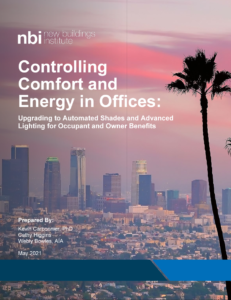
Controlling Comfort and Energy in Offices: Upgrading in Automated Shades and Advanced Lighting for Occupant and Owner Benefits
Interior lighting and window shading innovations have advanced leaps and bounds in the past two decades. Each innovation offers benefits to existing buildings, ranging from improved occupant comfort and wellbeing to significant energy savings. Geared toward building owners and operators, this market facing guide outlines the benefits and best practices to implement lighting and shading retrofits in today’s market.
Reopening Office Buildings: Creating a Healthy Environment for Occupants and the Planet
This white paper provides an overview and summary of the multiple building systems that affect occupants’ return to a safe indoor air environment, their energy use implications, and recommendations for best practices. Included is Retrofit and Reopening Recommendations for Offices—a checklist resource for facility managers and owners.
Accompanying blogs discuss the relationship between buildings and climate change and how strategies for returning to work can help, or hurt, climate goals along with retrofit ideas: Buildings’ Impact on Pandemics and Future-Proofing Buildings for a More Resilient Tomorrow.
Installer Guide
This guide enables architects, designers, engineers, installers and building operators to maximize the many benefits of the INTER Technology Solution, integrating networked lighting controls (NLC) systems and automated window shades retrofits with HVAC system retro-commissioning. The guide defines project roles and considerations and provides guidance for design, specification, and installation of these integrated retrofits. The guide also provides resources for building occupants and operators to better understand these new systems and their benefits.
Access the Guide
CASE STUDIES
Santa Ana City Hall
The City Hall building in Santa Ana sought to improve their indoor environment and save on energy costs with automated shades, upgraded lighting fixtures and networked lighting controls. The project updated the existing T8 lamps to LEDs and controlled the lighting with the existing Daintree system, resulting in over 40% lighting energy savings. The solar-powered automated shades by Rollease Acmeda provided operator pre-settings for daylight responsiveness and occupant customization for glare and heat control. The retrofit covered over 2400 light fixtures and 481 windows in this 127,000 square foot office building.
CSU Dominguez Hills Welch Hall
The Welch Hall building on the CSUDH campus partnered with the project team to retrofit their existing Enlighted lighting system and manual shades to the INTER package – which included LED lighting with Luminaire-level lighting control (LLLC), solar-powered automated shades, and HVAC retro-commissioning. The extensive retrofit covered nearly 2,000 lighting fixtures and over 400 windows in this 183,000 square foot administrative and classroom building.
Automated Window Treatment Case Study
Several manufacturers offer innovative window treatment solutions that allow daylight into spaces while controlling for glare and allowing views to the outdoors. In this case study, we focus on Indoor Sky’s Daylighter Shading System. The system has two parts: automated roller shades for the view portion of the windows, and automated lightshelves above. Read more about this solution and its benefits for both owners and occupants in our case study.
Read the Case Study Here
PROJECT RESULTS
The project included detailed laboratory testing and field demonstrations at two sites. The full project report can be found here.
Lab Savings
At the Berkeley FLEXLAB, the team tested the integration of the automated shades and the advanced networked LED lighting against two baseline conditions to evaluate the potential savings in lighting energy use, cooling load, and heating load across various seasons. The testing included several configurations, each of which was testing for approximately a week at a time. The results show that even when compared to new California Title 24 construction standards, significant lighting demand savings are available from LED lighting and extensive dimming in response to the shading system providing daylight in the perimeter zones.
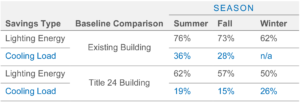
Field Savings
The project achieved significant energy reduction at both sites, primarily driven by reduced lighting energy use thanks to the LED retrofit, advanced controls and provision of daylighting through the shade component. The goal for the package was to reach 20% whole building energy savings. At Santa Ana City Hall, data availability issues surrounding the district steam consumption limited the analysis to savings from other fuels only. The true savings are likely greater than the 15% reported.

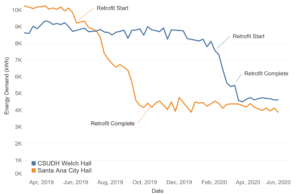
Final Report
Project Webinar
Existing Building Retrofits: An integrated solution set for energy and occupant benefits
Watch the Webinar
PROJECT TEAM AND SUPPORTERS
Funder: California Energy Commission (CEC) Electric Program Investment Charge (EPIC 16-302)
Match Funders:
Southern California Edison (SCE)
SBT Alliance
BeMotorized
City of Santa Ana
CSU Dominguez Hills
LBNL
Rollease Acmeda
Project Team:
NBI
TRC
LBNL
The Energy Coalition
Taylor Engineering
Primary Project Contacts:
Cathy Higgins and Kevin Carbonnier, New Buildings Institute
Contact Cathy or Kevin by email with any questions.
Demonstration Partners:
City of Santa Ana
CSU Dominguez Hills
Manufacturing Partners:
Rollease Acmeda
Daintree
BeMotorized
Installers:
Lumenomics
SBT Alliance
BeMotorized
Siemens
Orrovan Mechanical
Project Letters of Support:
Attachment Energy Rating Council (AERC)
Integral Group
ARUP
EHDD
P2S Engineering
Taylor Engineering
UC Berkeley Center for Environmental Design Research
San Diego Gas and Electric (SDG&E)
U.S. Department of Energy (DOE)
Technical Advisory Committee:
Kostas Papamichael, California Lighting Technology Center
Lisa Heschong, Consultant
Jonathan Changus, Northern California Power Agency
Amy Jiron, Department of Energy (DOE)
Bryan Cope, Southern California Public Power Authority
Kent Petersen, P2S
Adel Suleiman, California Energy Commission
Kim Rodriguez, Intech Energy
Travis Nelson, ComEd
Nancy Ander, California Department of General Services
Eric Knops, California Energy Commission
Drew Quirk, Xcel
Pierre Delforge, NRDC
Brian Smith, PG&E
Jai Agaram, Digital Energy, Inc.,
Ann McCormick, Newcomb Anderson McCormick

